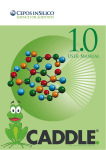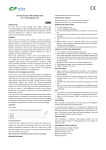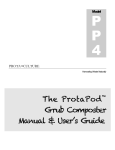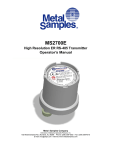Download department of homeland security us customs and border protection
Transcript
DEPARTMENT OF HOMELAND SECURITY U.S. CUSTOMS AND BORDER PROTECTION NOTICE OF ISSUANCE OF FINAL DETERMINATION CONCERNING POCKET PROJECTORS AGENCY: U.S. Customs and Border Protection, Department of Homeland Security. ACTION: Notice of final determination. SUMMARY: This document provides notice that U.S. Customs and Border Protection (‘‘CBP’’) has issued a final determination concerning the country of origin of pocket projectors. CBP was asked to consider two manufacturing scenarios, under which certain operations would be performed in Taiwan or in China. Based upon the facts presented, CBP has concluded that the manufacturing and testing operations performed in Taiwan do not substantially transform the non-TAA country components. The light engine module and the PCBA main board are the essence of the projectors and it is at their production where the last substantial transformation occurs. Therefore, when the light engine module and PCBA main board module are assembled and programmed in China, the country of origin of the projectors is China for purposes of U.S. government procurement. However, if the light engine module and PCBA main board module are assembled and programmed in Taiwan, then the country of origin of the projectors is Taiwan for purposes of U.S. government procurement. DATE: The final determination was issued on May 18, 2011. A copy of the final determination is attached. Any party-at-interest, as defined in 19 C.F.R. § 177.22(d), may seek judicial review of this final determination on or before [insert 30 days from date of publication in the Federal Register]. FOR FURTHER INFORMATION CONTACT: Heather K. Pinnock, Valuation and Special Programs Branch: (202) 325-0034. SUPPLEMENTARY INFORMATION: Notice is hereby given that on May 18, 2011, pursuant to subpart B of part 177, U.S. Customs and Border Protection Regulations (19 C.F.R. Part 177, subpart B), CBP issued a final determination concerning the country of origin of pocket projectors which may be offered to the U.S. Government under an undesignated government procurement contract. This final determination, HQ H114395, was issued under procedures set forth at 19 C.F.R. Part 177, subpart B, which implements Title III of the Trade Agreements Act of 1979, as amended (19 U.S.C. § 2511–18). In the final determination, CBP concluded that, based upon the facts presented, the manufacturing and testing operations performed in Taiwan do not substantially transform the non-TAA country components of the projectors. The light engine module and the PCBA main board are the essence of the projector and it is at their production where the last substantial transformation occurs. Therefore, when the light engine module and PCBA main board module are assembled and programmed in China, the country of origin of the projectors is China for purposes of U.S. government procurement. However, if the light engine module and PCBA main board module are assembled and programmed in Taiwan, then the country of origin of the projectors is Taiwan for purposes of U.S. government procurement. Section 177.29, CBP Regulations (19 C.F.R. § 177.29), provides that a notice of final determination shall be published in the Federal Register within 60 days of the date the final determination is issued. Section 177.30, CBP Regulations (19 C.F.R. § 177.30), provides that any party-at-interest, as defined in 19 C.F.R. § 177.22(d), may seek judicial review of a final determination within 30 days of publication of such determination in the Federal Register. DATED: May 18, 2011 Sandra L. Bell Executive Director Regulations and Rulings Office of International Trade Attachment HQ H114395 May 18, 2011 CLA-2 OT:RR:CTF:VS H114395 HkP CATEGORY: Marking Munford Page Hall, Esq. William C. Sjoberg, Esq. Adduci, Mastriani & Schaumberg LLP 1200 Seventeenth Street, NW Washington, DC 20036 RE: Request for Final Determination on the Country of Origin of Pocket Projectors Dear Mr. Hall and Mr. Sjoberg: This is in response to your letter dated July 6, 2010, requesting a final determination on behalf of a U.S. importer, pursuant to subpart B of part 177 of the U.S. Customs and Border Protection (CBP) Regulations (19 C.F.R. Part 177). Under these regulations, which implement Title III of the Trade Agreements Act of 1979 (TAA), as amended (19 U.S.C. § 2511 et seq.), CBP issues country of origin advisory rulings and final determinations as to whether an article is or would be a product of a designated country or instrumentality for the purposes of granting waivers of certain “Buy American” restrictions in U.S. law or practice for products offered for sale to the U.S. Government. This final determination concerns the country of origin of a pocket projector. We note that the U.S. importer is a party-at-interest within the meaning of 19 C.F.R. § 177.22(d)(1) and is entitled to request this final determination. In reaching our decision we have taken in account additional information submitted to this office on September 27, 2010. FACTS: According to the information submitted, the pocket projector is a 1.97” x 0.59” x 4.06”, four ounce, digital light processing (DLP) projector that uses light emitting diodes (LEDs) as its light source to project photos and videos from mobile devices onto any surface. It can produce an image size of up to 60 inches. The projector is partly comprised of the following components. Components of Taiwanese origin are: (1) A digital micromirror device (DMD) (an optical semiconductor; an extremely precise light switch that enables light to be modulated digitally via millions of microscopic mirrors arranged in a rectangular array. Each mirror is spaced less than 1 micron apart); (2) A Digital Photonic Processor (DPP) 1505 chip that drives the DMD and stores image data; (3) An Electrically Erasable Programmable Read-Only Memory (EEPROM) chip (PROM 1505 chip); (4) Light emitting Diodes (LEDs); (5) Lenses that control light for each designated location; (6) A printed circuit board assembly integrated circuit (PCBA-IC); (7) PCBs for the main board and DMD board; and, (8) The battery. In addition, two types of firmware are developed in Taiwan. The first type of firmware is made up of four categories of data, developed in either the U.S or Taiwan, that are programmed into the EEPROM: 1) the startup logo image that is projected on the screen when the projector is turned on (developed in Taiwan), (2) test patterns that are projected on the screen to determine whether the projector meets specifications (developed in the USA), (3) red/green/blue (RGB) LED duty cycle settings (developed in the USA), and (4) the Gamma table, which affects the voltage-to-light intensity of the RGB LEDs (developed in the USA), compiled into one binary file. The second type of firmware is designed and written in Taiwan. It is stored in a flash memory chip mounted on the PCBA main board and is accessed by the video display controller, also on the main board. Once the projector is operational, the memory chip will send the information in its file to the processor, i.e., the DPP 1505 chip that drives the DMD chip, as well as to the thermal thermistor and to the audio processor. Components of Chinese origin are: (1) The projecting lens; (2) Mirrors; (3) Parts related to electrical function (e.g., ICs capacitors, resistors, inductors and transistors). Components of Japanese origin are: (1) The fly eyes, a lens array which provides light uniformity; and (2) PCBA ICs. Components of Thai, U.S., Korean, and Malaysian origin are: PCBA ICs. In the first scenario we have been asked to consider, the PCBA-ICs from Japan, Thailand, the U.S., Korea, and Malaysia, and fly eyes from Japan will be shipped to China. Some Taiwanese origin components (DMDs, DPP 1505 chips, EEPROMs, LEDs, and lenses) will also be shipped to China to be assembled with Chinese-origin components (PCBs, projecting lenses, mirrors, and mechanical parts), the ICs, and fly eyes to make modules for the light engine and the PCBA main board. In China, both types of Taiwanese firmware for operating the projector will also be downloaded to memory chips located on the light engine and PCBA main board modules. The modules assembled in China will then be shipped to Taiwan where they will undergo quality inspections. In the second scenario, the PCBA-ICs from Japan, Thailand, the U.S., Korea, and Malaysia, and fly eyes from Japan will be shipped to Taiwan. The assembly and programming operations that take place in China, described in the first scenario, will all be performed in Taiwan. The next process occurs only in Taiwan, regardless of whether the processes described above are performed in China or Taiwan. A top cover, high viscosity protection film, transparent LED lens, top graphite plate, two thermal pads, a slide switch, inside and outside lens covers, an anti-dust sponge, and a screw, will be assembled to form the “top cover module.” A bottom cover, battery pull tape, EMI mylar cover, and graphite plate will be assembled to form the “bottom cover module.” The engine module and the PCBA main board subassemblies imported from China will then be assembled with the top and bottom cover modules, as well as with components such as a focus ring, washer, screws, audio-video connector and battery covers, rubber feet, and a speaker, to create a complete pocket projector. Assembly processes in Taiwan include gluing, screwing, fitting and inserting, and adhering by electrostatic means. The finished projector will undergo a series of tests in Taiwan: a pre-test, a run-in test, and a function test. The pre-test consists of: ensuring that the projector has the correct current value; using a programmable video pattern generator to check the projected logo, firmware version and model name while the projector is in Service Mode; and, if necessary, updating (reprogramming) the firmware installed in China. The run-in test ensures that the projector displays a clear image over a set period of time, and is conducted by manipulating the focus ring and making menu selections on the projector while it is in Service Mode. The function test involves: checking resolution, flare, unbalance, gray scale, color uniformity, projection image, and white pattern; connecting the projector to a programmable video pattern generator to check the master pattern for abnormal image and color lines; audio testing using a DVD player; verifying battery charge/discharge by inserting a fully charged battery into the projector to ensure that the projector works; using a light meter to measure brightness, color uniformity, contrast ratio, and color coordinate; using menu selections while in Service Mode to double check model name, firmware version and run-in time; and, if necessary, using menu selections while in Service Mode to adjust the color parameter of the firmware on the PCBA main board to optimize the projection image. After the projector passes the function test, it will be sent to the packing department where it will be packaged with an accessory kit, a user manual, a warranty and other product literature. ISSUE: What is the country of origin of the pocket projector for purposes of U.S. government procurement? LAW AND ANALYSIS: Pursuant to Subpart B of Part 177, 19 CFR § 177.21 et seq., which implements Title III of the Trade Agreements Act of 1979, as amended (19 U.S.C. § 2511 et seq.), CBP issues country of origin advisory rulings and final determinations as to whether an article is or would be a product of a designated country or instrumentality for the purposes of granting waivers of certain "Buy American" restrictions in U.S. law or practice for products offered for sale to the U.S. Government. Under the rule of origin set forth under 19 U.S.C. § 2518(4)(B): An article is a product of a country or instrumentality only if (i) it is wholly the growth, product, or manufacture of that country or instrumentality, or (ii) in the case of an article which consists in whole or in part of materials from another country or instrumentality, it has been substantially transformed into a new and different article of commerce with a name, character, or use distinct from that of the article or articles from which it was so transformed. See also 19 C.F.R. § 177.22(a). In determining whether the combining of parts or materials constitutes a substantial transformation, the determinative issue is the extent of operations performed and whether the parts lose their identity and become an integral part of the new article. Belcrest Linens v. United States, 573 F. Supp. 1149 (Ct. Int’l Trade 1983), aff’d, 741 F.2d 1368 (Fed. Cir. 1984). Assembly operations that are minimal or simple, as opposed to complex or meaningful, will generally not result in a substantial transformation. In order to determine whether a substantial transformation occurs when components of various origins are assembled into completed products, CBP considers the totality of the circumstances and makes such determinations on a case-by-case basis. The country of origin of the item’s components, extent of the processing that occurs within a country, and whether such processing renders a product with a new name, character, and use are primary considerations in such cases. Additionally, factors such as the resources expended on product design and development, the extent and nature of post-assembly inspection and testing procedures, and worker skill required during the actual manufacturing process will be considered when determining whether a substantial transformation has occurred. No one factor is determinative. You argue that, regardless of where assembly and programming operations take place, Taiwan is the country of origin of the projector because Taiwan is the location where the following actions occur: design and development of the projector, including the PCBA used in the projector; addition of the majority of value of the projector, both in terms of value and labor; fabrication of many of the parts, including the DMD, the DPP 1505 chip, the PROM 1505 chip and the LEDs; development of the firmware; the disparate parts are enabled and made into a functional projector; testing and adjustments; and, packing. In support of your argument you cite Headquarters Ruling Letters (HQ) H100055 (May 28, 2010), HQ H034843, (May 5, 2009), HQ H015324 (April 23, 2008), and HQ 555578 (June 11, 1990), among others. HQ H100055 concerned the country of origin of a motorized lift unit, designed, developed and engineered in Sweden, for an overhead patient lift system. The unit was assembled by teams of employees in a four segment process: manufacturing the electrical motor, drum and motor package in a 17 step process; mounting batteries and installing the exterior covers of the drum/motor assembly in a 5-step process; connecting a PCBA to the motor, housed drum and batteries in a three-step process; and, assembling the emergency strap, cover and end caps in a 14-step process. The PCBA was assembled and programmed prior to its importation in Sweden but it was designed in Sweden and its software program was written in Sweden. In addition the completed lift unit was tested in Sweden by an accredited testing institute. CBP found that the manufacturing and testing operations in Sweden were sufficiently complex and meaningful to transform the individual components into the lift unit, thereby making Sweden the country of origin of the unit. HQ H034843 concerned the country of origin of a USB flash drive partially manufactured in China and in Israel or the United States. Assembly took five minutes to complete and involved six manufacturing steps: initial quality control, component mounting; device housing; software installation and customization; system diagnosis and testing; and packaging. The first three steps took place in China and the last three in Israel or the United States. CBP concluded that there was a substantial transformation either in Israel or in the United States, depending on the location where the final three manufacturing operations took place. You refer to the fact that in reaching our decision, CBP noted that the installation of the firmware and the application software (developed in Israel) made the flash drive functional and executed its security features, and that their installation and customization greatly increased the value of the flash drive. In HQ H015324, CBP was asked to determine the country of origin of stereoscopic displays assembled in the U.S. from non-U.S. parts. The displays consisted of two LCD monitors, from China or Taiwan, mounted in a custom-made stand with a special beamsplitter mirror mounted at a bisecting angle between the two monitors. A graphics card in the computer transmitted right eye and left eye video separately. The importer would send one of the monitors to a third-party in the U.S. for an optical transformation process, after which the displays would be assembled, aligned and tested. CBP found that the processing and assembly operations in the U.S. resulted in a substantial transformation of the imported LCD monitors and the beamsplitter mirror into a product with a new name, character and use. In particular, we found that the polarization process performed in the U.S. changed the essential character of the LCD and imparted the stereoscopic functionality to the entire system. In addition, the assembly, testing and alignment of the display required a significant amount of time and precision by skilled technicians. In HQ 555578, overhead projectors were produced in Haiti from components of Belgian and U.S. origin, as well as from parts fabricated in Haiti. CBP concluded that the operations performed in Haiti constituted more than a simple combining operation and resulted in a new and different article of commerce with a new name, character and use. In this case, PCBs, memory chips, the DPP chip, integrated circuits, lenses, and LEDs from Taiwan; mirrors, the projecting lens, and various mechanical parts, including those relating to electrical function, from China; fly eyes and ICs from Japan; and, ICs from Thailand, the United States, Korea, and Malaysia, are assembled into the light engine module and the PCBA main board module in China or Taiwan. Through these operations, the individual parts lose their identities and become integral to the new and different articles. See Belcrest Linens. If these operations take place in China, the first scenario, then the country of origin would be China. If they take place in Taiwan, the second scenario, then the country of origin of the modules would be Taiwan. See HQ H015324 and HQ 555578. After carefully considering the pertinent facts, we find that the assembly of the light engine module and the PCBA main board module, although not described to us, by their nature should include attaching active and passive as well as other components to a bare printed circuit board by soldering, gluing and other means, and is technically complex. Further, the light engine module and the PCBA main circuit board have all the major components necessary for the pocket projector to complete its function. These components are: the DMD, the processor chip that drives the DMD, the EEPROM chip programmed with firmware, and other ICs; lenses; and mirrors. See generally, How DLP Projectors Work, wwwgizmohighway.com/ hifi/dlp_projector.htm (last accessed Nov. 9, 2010). Therefore, we find that the light engine module and PCBA main board manufactured in China or Taiwan impart the essential character of the projector. If the light engine module and PCBA main board module are assembled and programmed in China then, upon importation into Taiwan, the Chinese modules are joined together with a cable and then fitted into the top and bottom covers of the projectors made in Taiwan, which are then screwed and/or glued together. All together, the assembly, testing, and packaging operations in Taiwan consist of 80 steps and take approximately 2 hours and 20 minutes to complete. Applying the principle in Belcrest Linens, we find that the fit-together, glue and screw operations undertaken in Taiwan are not sufficiently complex and meaningful to transform the Chinese modules, which are the essence of the projector, into a new article with a new name, use and identity. Moreover, the Taiwanese subassemblies, the top and bottom covers of the projectors, are not necessary for the projector to function. In addition, the testing performed in Taiwan merely consists of turning on and running the projector and adjusting its preprogrammed menu selections. Based on these facts, we find that the last country where a substantial transformation occurs is China. Therefore, the country of origin of the projectors is China. If, however, the light engine module and PCBA main board module are assembled and programmed in Taiwan, then the country of origin would be Taiwan. We note that HQ H034843 is distinguishable from this case. In HQ H034843, the components of the flash drives were mounted and housed in one country and then the completed drives were shipped to another country for programming. Likewise, a different fact pattern also occurs in HQ H100055. In that case, the programming of the PCB took place in one country and the assembly of the lift unit, including the incorporation of the programmed PCB into the unit, took place in another. The motor and drum assembly that formed the essence of the lift unit was made in Sweden and the PCBA, which was programmed with software designed and written in Sweden, was incorporated into the unit in Sweden. In the present case, however, the essential components of the projector (the engine light module and the PCBA main board) are fabricated in the same country in which they are programmed, either China or Taiwan, and housed in Taiwan. HOLDING: Based on the facts in this case, we find that the manufacturing and testing operations performed in Taiwan do not substantially transform the non-TAA country components. The light engine module and the PCBA main board are the essence of the projector and it is at their production where the last substantial transformation occurs. Therefore, when the light engine module and PCBA main board module are assembled and programmed in China, the country of origin of the projectors is China for purposes of U.S. government procurement. However, if the light engine module and PCBA main board module are assembled and programmed in Taiwan, then the country of origin of the projectors is Taiwan for purposes of U.S. government procurement. Notice of this final determination will be given in the Federal Register, as required by 19 C.F.R. § 177.29. Any party-at-interest other than the party which requested this final determination may request, pursuant to 19 C.F.R. § 177.31, that CBP reexamine the matter anew and issue a new final determination. Pursuant to 19 C.F.R. § 177.30, any party-at-interest may, within 30 days of publication of the Federal Register Notice referenced above, seek judicial review of this final determination before the Court of International Trade. Sincerely, Sandra L. Bell, Executive Director Regulations and Rulings Office of International Trade [FR Doc. 2011-12713 Filed 05/23/2011 at 8:45 am; Publication Date: 05/24/2011]



















